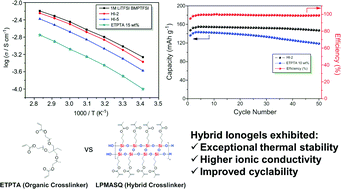Hybrid ionogel electrolytes for high temperature lithium batteries†
Abstract
Hybrid ionogels fabricated using 1 M LiTFSI in N-butyl-N-methylpyrrolidinium bis(trifluoromethylsulfonyl)imide (BMPTFSI) crosslinked with ladder-like structured poly(methacryloxypropyl)silsesquioxane (LPMASQ) were investigated as high temperature ionogel electrolytes for lithium ion batteries. In addition to the exceedingly low crosslinker concentration (∼2 wt%) required to completely solidify the ionic liquids, which provided high ionic conductivities comparable to the liquid state ionic liquid, these hybrid ionogels exhibited superior thermal stabilities (>400 °C). Rigorous lithium ion battery cells fabricated using these hybrid ionogels revealed excellent cell performance at various C-rates at a variety of temperatures, comparable with those of neat liquid electrolytes. Moreover, these hybrid ionogels exhibited excellent cycling performance during 50 cycles at 90 °C, sustaining over 98% coulombic efficiency. Highly advantageous properties of these hybrid ionogels, such as high ionic conductivity in the gel state, thermal stability, excellent C-rate performance, cyclability and non-flammability, offer opportunities for applications as high temperature electrolytes.


 Please wait while we load your content...
Please wait while we load your content...